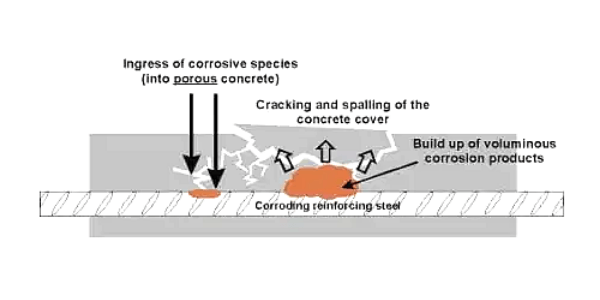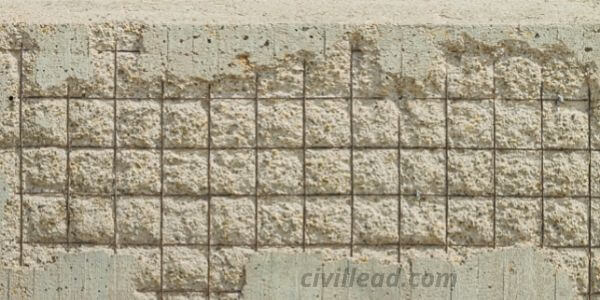Table of Contents
What is Concrete Spalling?
Spall means break (concrete, rock, stone, or ore) into small sections. Spalling of concrete or Concrete Spalling is the break of concrete in small sections, chipping off the main body exposing the reinforcement due to natural weather or chemical reaction, often resulting in the fractured concrete surface.
Spalling appears like pitted acne scarring and separates in speckle, exposing reinforcement. This section size maybe 6 inches or greater in diameter and one inch or more in-depth. As per ACI, 302.1R-4 happening of smaller spall sections is also possible.
Concrete spalling affects various structures such as framed structure buildings, bridges, tanks, jetties, etc. It makes the concrete surface patchy and pitted and exposes underneath aggregate.
As soon as spalling occurs, it should be repaired appropriately. Otherwise, it compromises the integrity of the concrete surface and threatens the maximum ability of the component. Moreover, it distorts the aesthetic appearance of the structural member.
A common issue usually found in old concrete structures is spalling of concrete. The primary reason for spalling of concrete is the corrosion of steel bars inserted in concrete.
But there are some other ferrous components embedded in concrete either fully or partially due to which concrete spalling occurs, such as structural I beam, handrails, steel window frame, conduits, metal pipe, etc.

Nevertheless, corrosion of the steel reinforcement bar is the most common cause for spalling and splitting in old concrete structures.
Reinforcing steel is used in concrete to increase its tensile strength. As we know, concrete has excellent compressive strength but low tensile strength.
One of the primary factors for corrosion safety is the thickness of the concrete cover protecting the reinforcing steel.
As per the thumb rule, a concrete cover of one inch or double the diameter of the main bar is necessary to protect the steel bar.
Another essential factor for the protection rebar is ensuring that the concrete is adequately compacted during pouring.
Apart from environmental factors, the poor concrete mix means not having the proper ratio of ingredients while preparing the concrete, and poor workability induces concrete spalling.
Good consolidation is gained by placing concrete with the appropriate consistency and compaction of the wet concrete before it starts to harden.
It is tough to compact properly too stiff concrete with a low water-cement ratio, resulting in the left of air voids in the finished member.
If voids are considerable in size, they can extend via wall structure and give passage to water to contact the bar, resulting in corrosion.
Causes of Spalling of Concrete
There are various reasons due to which spalling of concrete occurs are as follows.
- Corrosion of embedded steel reinforcement. Corroding steel hold more additional volume than the original, and it can extend up to ten times its initial volume, exerting force on the surrounding concrete.
- Freeze and thaw cycling.
- Exposure to fire.
- Insufficient thickness concrete cover to reinforcement.
- Poor-quality concrete cover to steel reinforcement.
- Alkali-Silica Reaction’s Expansive effects.
- Improperly constructed joints often cause joint spalls, leading to joint spalling.
- Failure of bond in two-course construction because of shrinkage variation between top and base courses, drying the bonding grout before placing the top concrete course, etc.
How to Prevent Concrete Spalling
- Early-entry dry-cut in concrete floor slabs helps prevent concrete spalling.
- Use suitable water sealant on the finalized surface to stop water from entering the concrete.
- During concrete pouring, proper supervision can help ensure adequate cover to reinforcement and placement of joints at suitable places.
- Avoiding extra water in the concrete mix helps to prevent spalling of concrete.
Repairing of Spalling of Concrete

The repair procedure of concrete spalling differs depending on the concrete structure’s damage intensity, type, and location. It must be according to relevant codes such as ACI Code and BS EN 1504.
Cleaning of Spalled Concrete Area
Firstly clean the area that needs repairing from dirt to avoid bond breaker agents. In case heavy dirt and stains may require a pressure washer to clean the surface properly.
Removal of Loose Concrete
Remove the broken and loose concrete via chisel and hammer from the area. In some cases grinding or shot blasting may also require for preparing the surface properly. For successful repair, it is preferred to remove concrete at a depth of about 3.81 cm.
For finding any possible deterioration, tapping of the nearby area is advisable. Deteriorate concrete produces a hollow sound, and it should be removed to avoid future concrete repair.
For better results, it is advisable to cut the concrete in a rectangular section to do the patching and get the concrete mix within the specified area. Now, clear dust and debris with the help of a vacuum.
Cleaning of Corroded Steel Bars
Now clean the reinforcement bars corrosion and dirt and apply a protective coating to bypass rusting.
Application of Repair Material
Based on the type of concrete spalling repair, various products are used. Surface repair is suitable if the spalling depth is lower than 1/3 of the concrete thickness/depth.
But damages greater than 1/3 of the concrete depth require complete depth restoration with steel bar installation.
Firstly rough the affected surface and apply suitable adhesive for solid bonding. The restore the surface by right admixture.
Portland-cement-based or epoxy is The best-recommended patching material. It is essential to choose material for patching with thermal expansion near existing concrete. The ambient temperature should be above the 4°c during repairing to avoid any effects.
Damage to horizontal surfaces like walkways and driveways may be restored with a cementitious overlay.
If the damaged area is neighbouring to a joint, ensure that it is appropriately restored to allow expansion of the particular member.
Finishing
For finishing off the surface, remove the excess material by margin trowel and finish the surface by the level it.
Curing
To ensure the required strength cure the applied material properly.
Painting or Coating on Repaired Surface
To avoid future concrete spalling, apply paint or waterproofing membrane after setting the material thoroughly.
Thanks!
Also, Read
Grade of Concrete And Their Uses
What are the Properties of Fresh Concrete?
Monolithic Slab Vs Floating Slab
Grade Beam, Grade Beam Foundation – Construction Process, Advantages & Disadvantages